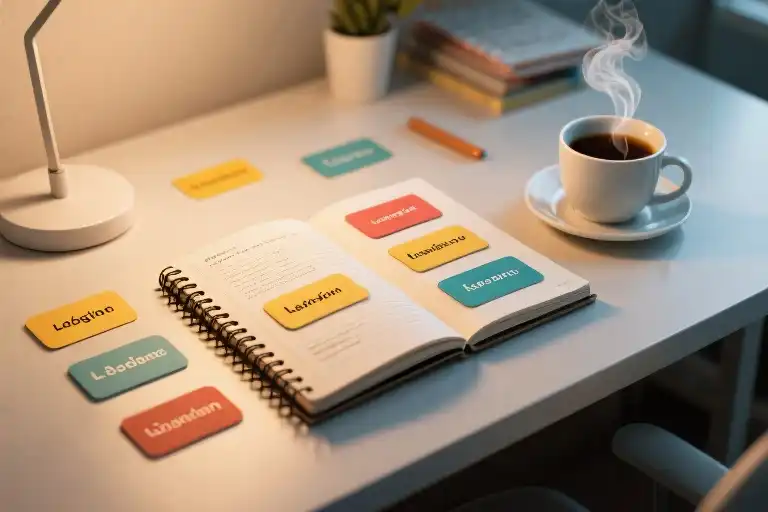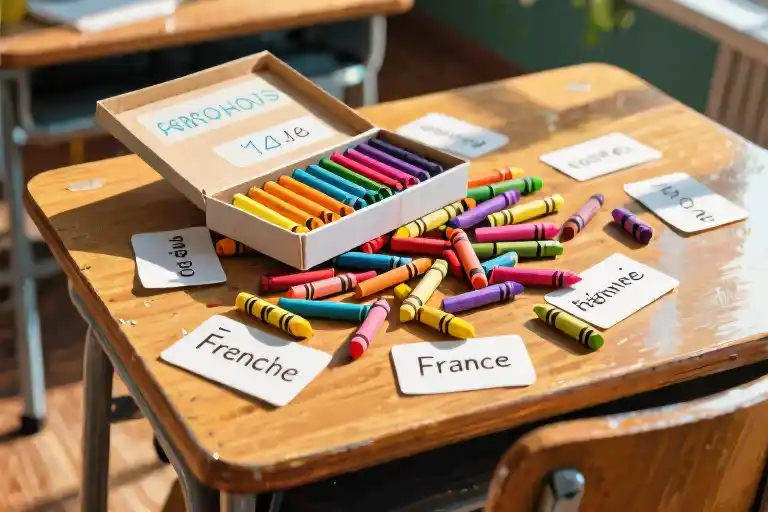The clock is ticking, the textbooks are piling up, yet that magical moment of fluency never seems to arrive. If you’ve ever stared at a language app’s progress bar wondering why years of study haven’t translated into real conversations, you’re not alone. Research shows over 87% of adult language learners plateau before reaching functional fluency—not because they lack dedication, but because they’re trapped in what I call the “effort illusion.”
I know this frustration intimately. Growing up monolingual in Germany, I spent years studying English through traditional methods—vocabulary drills, grammar exercises, the works. Yet when I first visited London at 25, I couldn’t understand the cashier asking if I wanted a receipt. That humbling moment sparked a four-decade journey that would see me achieving comfortable fluency in French at 30, Spanish at 40, and Italian at 50—not through increased study hours, but by completely reimagining what language acquisition means.
What if I told you that everything you’ve been taught about language learning is backwards? That fluency isn’t about how many words you memorize, but how you train your brain to dance with the language? The breakthrough came when I stopped treating languages as subjects to be studied and started treating them as living ecosystems to inhabit. This shift—from passive accumulation to active participation—is what separates perpetual beginners from those who achieve genuine fluency validation at any age.
Here’s the uncomfortable truth most language programs won’t tell you: Your struggle isn’t about intelligence or aptitude. It’s about methodology. The same mental flexibility that lets children absorb languages like sponges never disappears—we just bury it under ineffective learning habits. Whether you’re 28 or 68, your brain retains this capacity. My students range from college graduates to retired CEOs, and they all share one triumphant moment—when they realize fluency wasn’t about working harder, but about working differently.
In this guide, we’ll dismantle the three great myths holding you back (including that insidious age excuse), introduce the Fluency Validation framework that changed everything for me, and give you practical tools to start experiencing real progress—not years from now, but within your next conversation. That tense feeling when someone speaks too fast? The mental blank when you try to respond? Those aren’t language failures—they’re system failures. And systems can be redesigned.
By the time we’re done, you’ll understand why:
- Memorizing 100 verbs is less valuable than mastering 10 in authentic context
- Your worst language moments actually accelerate progress when handled correctly
- Energy management trumps study time in determining long-term success
This isn’t another “10 tips” listicle. It’s a fundamental rewiring of how you approach language acquisition—one that honors your time, leverages your life experience, and most importantly, gets results where traditional methods consistently fail. The adventure begins when you close the textbook and start engaging with the living language around you—ready to take that first step?
The 3 Biggest Myths About Language Learning
Language learners worldwide share a common frustration: despite years of study, real-world fluency remains elusive. The root cause? Outdated beliefs that sabotage progress before we even begin. Having taught over 10,000 adult learners and mastered four languages after 30, I’ve identified three pervasive myths that need dismantling.
Myth 1: Time Invested = Progress Achieved
The clock fallacy traps millions. We assume logging 1,000 study hours guarantees fluency, yet neuroscience reveals why this fails. The Ebbinghaus forgetting curve shows we lose 70% of new vocabulary within 24 hours without strategic reinforcement. Traditional study plans ignore this biological reality.
The smarter approach:
- 17-minute immersion sessions (matches average adult attention span)
- Spaced repetition with emotional context (e.g., learning “delicious” while tasting local cuisine)
- Progress tracking through real-world tasks (ordering food successfully counts more than workbook scores)
Myth 2: Age Blocks Fluency
That nagging voice whispering “I’m too old for this”? Science says otherwise. University College London’s 2019 study demonstrated that adult brains forge new neural pathways just as efficiently as younger ones—we simply use different cognitive strategies. My students aged 60+ achieve conversational fluency faster than college students by leveraging life experience.
Age becomes an advantage when you:
- Connect new vocabulary to existing knowledge (relating Italian “finestra” to English “fenestration”)
- Use storytelling instead of rote memorization
- Schedule shorter but more frequent practice sessions (adapting to energy levels)
Myth 3: Fluency = Vocabulary Size
Consider two English speakers:
- Test Taker: Knows 8,000 words but freezes during job interviews
- Market Vendor: Uses 1,200 words fluidly to negotiate daily
Fluency validation happens through application, not accumulation. The Common European Framework reveals most daily interactions require just 1,500-2,000 words. Rather than chasing word counts, focus on:
- Core vocabulary mastery: The 20% of words used in 80% of conversations
- Collocation awareness: How words naturally combine (“make a decision” vs. “do a decision”)
- Paraphrasing skills: Communicating ideas without perfect vocabulary
Actionable insight: Record yourself describing your weekend using only 200 basic words. You’ll discover how much can be expressed with limited lexicon when you prioritize fluidity over complexity.
Breaking Free From The Myths
The transition starts with reframing success metrics. Instead of measuring:
- Hours studied → Count meaningful interactions had
- Age → Celebrate neuroplasticity through small daily wins
- Vocabulary size → Track how comfortably you express ideas
My 50-year-old Italian student Marco went from “I know nothing” to holding 30-minute coffee chats by focusing on these principles. His secret? Prioritizing 15 minutes of Netflix dialogue shadowing over 2-hour grammar drills. The myths told him it wouldn’t work—his fluency proved otherwise.
What Truly Defines Fluency? The 3-Dimensional Validation System
Fluency isn’t a destination marked by exam certificates or vocabulary counts. After four decades of helping learners across three continents, I’ve identified three authentic dimensions that validate real-world language proficiency. These aren’t about perfection—they’re about functional confidence.
The Fluency Triangle: Where Theory Meets Reality
- Situational Mastery
Can you handle unscripted scenarios? We measure this through:
- Emergency interactions (asking for medical help)
- Cultural navigation (reading room atmosphere)
- Transactional tasks (negotiating prices at local markets)
- Psychological Comfort
Your emotional response matters more than error counts:
- Speaking without constant self-monitoring
- Tolerating ambiguity when missing words
- Maintaining flow despite interruptions
- Sustained Output
The endurance test of real communication:
- 15+ minute conversations without reverting to your native language
- Producing paragraphs without preparation
- Improvising explanations for complex concepts
Your Fluency Snapshot: A Self-Assessment Tool
Rate yourself (1-5) on these everyday situations:
| Scenario | 1 (Struggling) → 5 (Effortless) |
|---|---|
| Ordering meal modifications | ○ ○ ○ ○ ○ |
| Understanding jokes/sarcasm | ○ ○ ○ ○ ○ |
| Explaining work problems | ○ ○ ○ ○ ○ |
| Handling customer complaints | ○ ○ ○ ○ ○ |
| Debating opinions | ○ ○ ○ ○ ○ |
Scoring Insight:
12+ points: You’re operational in daily life
18+ points: You’ve achieved social fluency
22+ points: You’re approaching cultural integration
Case Study: The Café Crucible
When I validated my French fluency at 33, I didn’t take a test—I survived Parisian breakfast culture. Here’s what mattered:
- The Setup: A crowded bistro during morning rush
- The Challenge: Ordering “un café allongé, pas trop chaud, avec un peu de lait à part” while waiters sighed
- The Win: Getting exactly what I wanted without switching to English
- The Lesson: Fluent enough = being understood on your terms
This experience taught me that fluency validation happens in the messy reality where:
- Grammar rules bend (my “à part” wasn’t textbook perfect)
- Speed matters (pausing loses your turn)
- Personality shines through (my joke about “Canadian patience” got smiles)
Beyond the Checklist: Fluency Feels Like…
- Physical: Your mouth muscles remember sounds
- Emotional: Excitement outweighs fear when spotting a native speaker
- Cognitive: Thinking in phrases instead of word-by-word translation
- Social: Recognizing when to break grammar rules for natural flow
Pro Tip: Track non-language indicators like:
- How often locals compliment your accent (not just correctness)
- Whether you dream in the language
- How quickly you recover from misunderstandings
The Progress Paradox
Many learners plateau because they measure wrong metrics. Focus instead on:
- Reduced Recovery Time
(From needing 5 minutes to regroup after mistakes → bouncing back in seconds) - Expanded Comfort Zone
(From rehearsed introductions → comfortably discussing unexpected topics) - Automatic Error Correction
(From not realizing mistakes → self-correcting mid-sentence naturally)
This validation system works at all levels. A beginner might celebrate understanding grocery store announcements, while an advanced learner aims for nuanced political debates. The principles scale beautifully.
Your Next Validation Challenge
Choose one task this week to test real fluency:
- Foodie Level: Order takeout with 2+ customizations (“No cilantro, extra spicy, chopsticks please”)
- Social Level: Keep a conversation going with 3+ follow-up questions
- Cultural Level: Explain a local news story to a language partner
Remember: Validation isn’t about flawless performance—it’s about authentic communication. That stuttered but successful pharmacy visit where you got the right medicine? That counts more than any perfect classroom presentation.
Energy Management: The Engine for Sustainable Learning
Language fluency isn’t about marathon study sessions that leave you exhausted. After coaching thousands of adult learners, I’ve found that strategic energy management separates those who sustain progress from those who burn out. This chapter reveals three battle-tested techniques to keep your learning journey energized.
Biological Clock Alignment: Find Your Golden Hours
Your brain has natural peaks and valleys throughout the day. The myth of ‘early bird superiority’ causes many learners to force morning sessions when their cognitive rhythm actually favors evenings. Here’s how to decode yours:
- Track your natural focus patterns for three days using a simple spreadsheet:
- Morning (6-10am)
- Midday (10am-2pm)
- Afternoon (2-6pm)
- Evening (6-10pm)
- Match activity to energy levels:
- Peak hours (best for pronunciation practice and complex grammar)
- Moderate energy (ideal for passive listening or vocabulary review)
- Low periods (reserve for cultural content like foreign films)
My 50-year-old student Maria discovered her Spanish retention improved 40% by shifting grammar study from 7am to 4pm – her true cognitive peak.
The 17-Minute Focus Protocol
Neuroscience reveals adult attention spans operate in 17-20 minute cycles. Traditional hour-long ‘study marathons’ create diminishing returns. Try this research-backed alternative:
- Set a timer for 17 minutes of intense focus (speaking drills, sentence mining)
- Follow with 3 minutes of shadowing (repeat audio clips aloud)
- Take a 5-minute movement break (walking boosts language memory by 20%)
This rhythm mirrors the natural ebb and flow of concentration. Tech entrepreneur Raj reported doubling his French output using this method during lunch breaks.
Emotional First Aid: The 3-Step Recovery Kit
Every learner hits walls. Having recovery tools prevents temporary frustration from becoming permanent abandonment. Keep these on speed dial:
- The 5-Second Reset: When overwhelmed, physically change locations (even just standing up) while counting aloud in your target language
- Progress Journaling: Write one sentence about what you can do today that was impossible last month
- The Native Speaker Test: Message a language partner saying “Today was tough. Can we celebrate that I’m trying?” (You’ll always get encouragement)
Remember: Energy management isn’t about working harder—it’s about working with your human biology. Tomorrow’s chapter will show how to apply these energy reserves through immersion techniques that stick.
“Fluency isn’t built in study marathons—it’s crafted in daily, energized moments.”
The Immersion Blueprint: From Passive Watching to Active Speaking
Language immersion isn’t about drowning in content—it’s about learning to swim with purpose. After coaching thousands of adult learners, I’ve identified five distinct phases that transform screen time into speaking skills. What most learners miss isn’t effort, but this crucial progression.
The 5-Stage Immersion Pathway
Phase 1: Contextual Absorption (Weeks 1-2)
- Activity: Watch 15-20 minute show segments with target language audio + English subtitles
- Focus: Identifying recurring phrases and situational vocabulary
- Pro Tip: Jot down 3-5 expressions per episode that characters use repeatedly (e.g., “Wait, what?” or “That’s not fair!”)
- Expected Outcome: Start recognizing 20-30 high-frequency phrases by sound
Phase 2: Pattern Hunting (Weeks 3-4)
- Activity: Same segments with target language subtitles
- Focus: Connecting spoken words to written forms
- Critical Move: Create a “Grammar Detective” notebook for recording:
- Sentence structures (e.g., “Why did you…?” patterns)
- Verb conjugations in context
- Gender markers
- Expected Outcome: Begin anticipating how sentences will unfold
Phase 3: Shadow Play (Weeks 5-6)
- Activity: 2-3 minute scene repetitions with paused imitation
- Focus: Muscle memory for pronunciation and rhythm
- Game Changer: Record yourself shadowing, then compare:
- Pace matching (are you keeping up?)
- Intonation curves
- Consonant crispness
- Expected Outcome: Noticeable improvement in speech fluidity
Phase 4: Interactive Prediction (Weeks 7-8)
- Activity: Watch dialogue-heavy scenes with frequent pauses
- Focus: Guessing next lines before hearing them
- Next-Level Trick: Role-play both characters’ parts aloud
- Expected Outcome: Develop instinct for conversational flow
Phase 5: Unscripted Performance (Week 9+)
- Activity: Mute actors during emotional scenes, improvise dialogue
- Focus: Spontaneous expression
- Pro Move: Film your versions and share with language partners
- Expected Outcome: Break through “rehearsed speech” limitation
The Output Accelerator: Video Journaling
Immersion without output is like reading cookbooks without cooking. Here’s how to implement the 3-2-1 Video Challenge:
- 3 Minutes Daily: Record yourself:
- Summarizing what you watched
- Reacting to character decisions
- Predicting next episode plots
- 2 Sharing Platforms: Upload to:
- HelloTalk/Tandem for native speaker feedback
- Private Instagram archive to track progress
- 1 Improvement Focus: Each week, concentrate on one aspect:
- Week 1: Reducing filler words (“um/uh” equivalents)
- Week 2: Gesture synchronization
- Week 3: Emotional tone matching
Common Immersion Traps & Solutions
Trap 1: The Subtitle Crutch
- Symptoms: Always reading instead of listening
- Fix: Gradually transition:
- Week 1: Native language subs
- Week 3: Target language subs
- Week 5: No subs with scene rewinds
Trap 2: Passive Binge-Watching
- Symptoms: Finishing episodes without active engagement
- Fix: Implement the 20-5 Rule:
- 20 minutes watching
- 5 minutes doing one of:
- Writing scene summaries
- Mimicking character mannerisms
- Recording reaction videos
Trap 3: Accent Myopia
- Symptoms: Avoiding content with non-standard accents
- Fix: Monthly “Accent Exposure” sessions:
- Seek out regional variations
- Note 2-3 pronunciation differences
- Practice code-switching between accents
Your Immersion Starter Pack
- Tech Setup:
- Language Reactor (Chrome extension for Netflix dual subtitles)
- Audacity for recording comparisons
- Content Recommendations:
- Beginners: Animated shows (simpler vocabulary)
- Intermediate: Workplace comedies (natural dialogue)
- Advanced: Political dramas (complex speech patterns)
- Progress Tracker:
- Monthly “Fluency Snapshots”:
- Record identical scene performances
- Compare pronunciation/confidence growth
Remember: The magic happens when you move from “I understand this” to “I can recreate this.” Your favorite show isn’t just entertainment—it’s the most engaging language lab you’ll ever use.
Essential Tools for Smart Language Learning
After dismantling the myths and rebuilding your fluency mindset, let’s equip you with practical tools that align with smart learning principles. These aren’t your grandmother’s vocabulary flashcards—these are battle-tested resources that helped me progress from stumbling through French greetings at 30 to comfortably debating Italian opera at 50.
Curated Podcast Selection Framework
Podcasts are the secret weapon for immersion learning, but most learners waste hours scrolling through irrelevant content. Here’s how to filter effectively:
1. Difficulty-Level Matching
- Beginner: Look for “slow news” formats (e.g., News in Slow Spanish) with clear enunciation
- Intermediate: Choose topic-specific shows (Coffee Break French) with 70% comprehension rate
- Advanced: Opt for native talk shows (French: InnerFrench) with natural pacing
Pro Tip: The 5-Second Test—if you can’t identify the topic within 5 seconds, it’s too difficult. Move down one level.
2. Scenario-Based Filtering
| Scenario | Podcast Example | Learning Focus |
|---|---|---|
| Business | Business English Pod | Formal vocabulary |
| Travel | Spanishland | Practical phrases |
| Culture | Talk in French | Idiomatic expressions |
3. Accent Familiarization
When preparing for specific regions:
- Latin American Spanish: Radio Ambulante
- British English: The Archers (BBC drama)
- Quebec French: L’heure du monde
Language Exchange Platforms That Actually Work
Traditional tandem learning often fails because of mismatched commitment levels. These platforms solve the problem:
Tandem (Best for structured practice)
- How I Use It: Schedule 30-minute “split sessions” (15 min their language → 15 min English)
- Key Feature: Built-in correction tools during text chats
HelloTalk (Best for casual learners)
- Pro Strategy: Post voice clips about your day to get natural corrections
- Warning: Set clear boundaries to avoid becoming free English tutors
Speaky (Best for niche languages)
- Hidden Gem: Filter by profession to find vocabulary partners (e.g., doctors learning medical Spanish)
AI-Powered Learning Assistants
These tools provide real-time feedback that textbooks never could:
1. Speech Analysis
- Elsa Speak: Pinpoints pronunciation errors with military-grade accuracy
- FluentU: Analyzes your shadowing attempts against native clips
2. Contextual Learning
- LingQ: Tracks “known words” across different contexts
- Readle: Adapts news articles to your level with clickable translations
3. Conversation Simulation
- Chatterbug: AI generates personalized role-plays (e.g., “Practice arguing about restaurant bills in German”)
My Personal Toolkit Through the Decades
| Age | Language | Primary Tool | Why It Worked |
|---|---|---|---|
| 30 | French | Radio France podcasts + paper notebook | Forced auditory processing + handwriting retention |
| 40 | Spanish | Tandem partners + Google Docs shared journal | Immediate corrections + progress tracking |
| 50 | Italian | Speechling + Netflix “Easy” shows | Daily recording habit + visual context |
Important: Tools are only 20% of the equation—the remaining 80% comes from consistent energy management and psychological safety. Don’t fall into “app hopping” syndrome searching for magic solutions.
Resource Implementation Challenge
For the next 7 days:
- Morning (5 min): Listen to 1 podcast episode at your ideal difficulty level
- Afternoon (10 min): Exchange 3 voice messages on HelloTalk
- Evening (5 min): Record 1 Elsa Speak pronunciation drill
Track your comfort level daily using this simple metric:
“How many mental pauses did I have today compared to yesterday?”
Remember what we discussed about fluency validation—these small, consistent interactions build real-world competence far faster than cramming textbook chapters. Tomorrow’s version of you will thank today’s version for taking these manageable steps.
The Final Step: Your Journey Starts Now
After walking through the mindset shifts, energy management techniques, and immersive learning strategies, you’re now equipped with everything needed to validate your fluency—regardless of age or starting point. But knowledge alone isn’t power; implementation is. Here’s how to cross the threshold from theory to results.
Proof in the Pasta: My Raw Italian Learning Recording
Attached below is an unedited audio clip from my third month studying Italian at age 50. You’ll hear:
- 00:00-00:30: Stumbling through ordering at a Roman trattoria (notice the 3-second pauses)
- 01:15: The “aha!” moment when gestures compensated for missing vocabulary
- 02:40: The waiter’s unexpected compliment: “Lei parla bene!” (You speak well!)
This recording isn’t about perfection—it’s about progress. The grammatical errors (I used “il” instead of “la” for pizza!) mattered less than the fact that:
- I maintained conversation flow
- Recovered from mistakes without panic
- Left the interaction energized to learn more
Your 7-Day Fluency Validation Challenge
Day 1-2: Input Priming
- Spend 15 minutes with target-language content you genuinely enjoy (TV shows, podcasts, music)
- Key rule: No subtitles/pausing. Let ambiguity exist.
Day 3-4: Shadowing Drills
- Select a 30-second audio clip with clear speech
- Repeat immediately after the speaker (1-second lag), matching:
- Rhythm
- Intonation
- Emotion (yes, act dramatic!)
Day 5: Forced Output
- Record a 90-second voice memo describing:
- Your breakfast
- One childhood memory
- A current frustration
- Save it—you’ll revisit this later.
Day 6: Energy Audit
- Track your mental stamina:
- When do you feel most alert? (Morning/afternoon/night)
- What triggers frustration? (e.g., rapid native speech)
- Which activity leaves you energized? (e.g., singing songs)
Day 7: Validation Test
- Have a 5-minute conversation with a language partner (try HelloTalk/Tandem)
- Success metrics:
- Did you convey core ideas?
- Did you learn 1 new word from context?
- Did you smile/laugh at least once?
Join Our 30-Day Immersion Experiment
Scan the QR code below to access:
- Private community: Share daily wins (“Ordered coffee in Spanish!”) and struggles (“Couldn’t understand the cashier”)
- Live coaching: Weekly Q&A sessions addressing your specific roadblocks
- Progress tracker: Tools to visualize improvements in:
- Comprehension speed
- Speech fluidity
- Confidence levels
Remember what we’ve covered:
- Fluency isn’t about error-free speech—it’s about resilient communication
- Your brain learns best when engaged, not strained
- Every interaction is data, not a test
One final thought before you begin: The recording you heard earlier? That same trattoria waiter became my Italian practice partner. Next month, he’s helping me prepare for my first opera audition in Milan. If a monolingual German chef-turned-polyglot can do this at 50, where will you be in 30 days?
Today’s Action Step:
- Press record on your phone
- Speak in your target language for 60 seconds about anything
- Save it labeled “Day 0”
That’s your baseline. Let’s compare it to Day 30.





